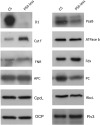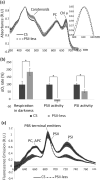Gene expression and organization of thylakoid protein complexes in the PSII-less mutant of Synechocystis sp. PCC 6803
- PMID: 35774619
- PMCID: PMC9219013
- DOI: 10.1002/pld3.409
Gene expression and organization of thylakoid protein complexes in the PSII-less mutant of Synechocystis sp. PCC 6803
Abstract
Photosystems I and II (PSI and PSII) are the integral components of the photosynthetic electron transport chain that utilize light to provide chemical energy for CO2 fixation. In this study, we investigated how the deficiency of PSII affects the gene expression, accumulation, and organization of thylakoid protein complexes as well as physiological characteristics of Synechocystis sp. PCC 6803 by combining biochemical, biophysical, and transcriptomic approaches. RNA-seq analysis showed upregulated expression of genes encoding the PSII core proteins, and downregulation of genes associated with interaction between light-harvesting phycobilisomes and PSI. Two-dimensional separation of thylakoid protein complexes confirmed the lack of PSII complexes, yet unassembled PSII subunits were detected. The content of PsaB representing PSI was lower, while the content of cytochrome b6f complexes was higher in the PSII-less strain as compared with control (CS). Application of oxygraph measurements revealed higher rates of dark respiration and lower PSI activity in the mutant. The latter likely resulted from the detected decrease in the accumulation of PSI, PSI monomerization, increased proportion of energetically decoupled phycobilisomes in PSII-less cultures, and low abundance of phycocyanin. Merging the functional consequences of PSII depletion with differential protein and transcript accumulation in the mutant, in comparison to CS, identified signal transduction from the photosynthetic apparatus to the genome level.
Keywords: D1 protein; RNA‐seq; Synechocystis sp. PCC 6803; photosynthesis; photosystem II; psbA2.
© 2022 The Authors. Plant Direct published by American Society of Plant Biologists and the Society for Experimental Biology and John Wiley & Sons Ltd.
Conflict of interest statement
The authors declare no conflicts of interests.The Authors did not report any conflict of interest.
Figures



Similar articles
-
Fluorescence changes accompanying short-term light adaptations in photosystem I and photosystem II of the cyanobacterium Synechocystis sp. PCC 6803 and phycobiliprotein-impaired mutants: State 1/State 2 transitions and carotenoid-induced quenching of phycobilisomes.Photosynth Res. 2009 Mar;99(3):227-41. doi: 10.1007/s11120-009-9402-x. Epub 2009 Jan 24. Photosynth Res. 2009. PMID: 19169839
-
Proteome analysis of response to different spectral light irradiation in Synechocystis sp. PCC 6803.J Proteomics. 2021 Aug 30;246:104306. doi: 10.1016/j.jprot.2021.104306. Epub 2021 Jun 19. J Proteomics. 2021. PMID: 34157441
-
Spectrally decomposed dark-to-light transitions in Synechocystis sp. PCC 6803.Photosynth Res. 2018 Aug;137(2):307-320. doi: 10.1007/s11120-018-0505-0. Epub 2018 Mar 29. Photosynth Res. 2018. PMID: 29600442
-
Gross morphological changes in thylakoid membrane structure are associated with photosystem I deletion in Synechocystis sp. PCC 6803.Biochim Biophys Acta. 2012 May;1818(5):1427-34. doi: 10.1016/j.bbamem.2012.01.019. Epub 2012 Jan 27. Biochim Biophys Acta. 2012. PMID: 22305964
-
Quantifying the Energy Spillover between Photosystems II and I in Cyanobacterial Thylakoid Membranes and Cells.Plant Cell Physiol. 2024 Jan 19;65(1):95-106. doi: 10.1093/pcp/pcad127. Plant Cell Physiol. 2024. PMID: 37874689
References
-
- Allahverdiyeva, Y. , Mustila, H. , Ermakova, M. , Bersanini, L. , Richaud, P. , Ajlani, G. , Battchikova, N. , Cournac, L. , & Aro, E. (2013). Flavodiiron proteins Flv1 and Flv3 enable cyanobacterial growth and photosynthesis under fluctuating light. Proceedings of the National Academy of Sciences, 110(10), 4111–4116. 10.1073/pnas.1221194110 - DOI - PMC - PubMed
-
- Allen, J. (1995). Thylakoid protein phosphorylation, state 1‐state 2 transitions, and photosystem stoichiometry adjustment: Redox control at multiple levels of gene expression. Physiologia Plantarum, 93, 196–205. 10.1034/j.1399-3054.1995.930128.x - DOI
LinkOut - more resources
Full Text Sources

